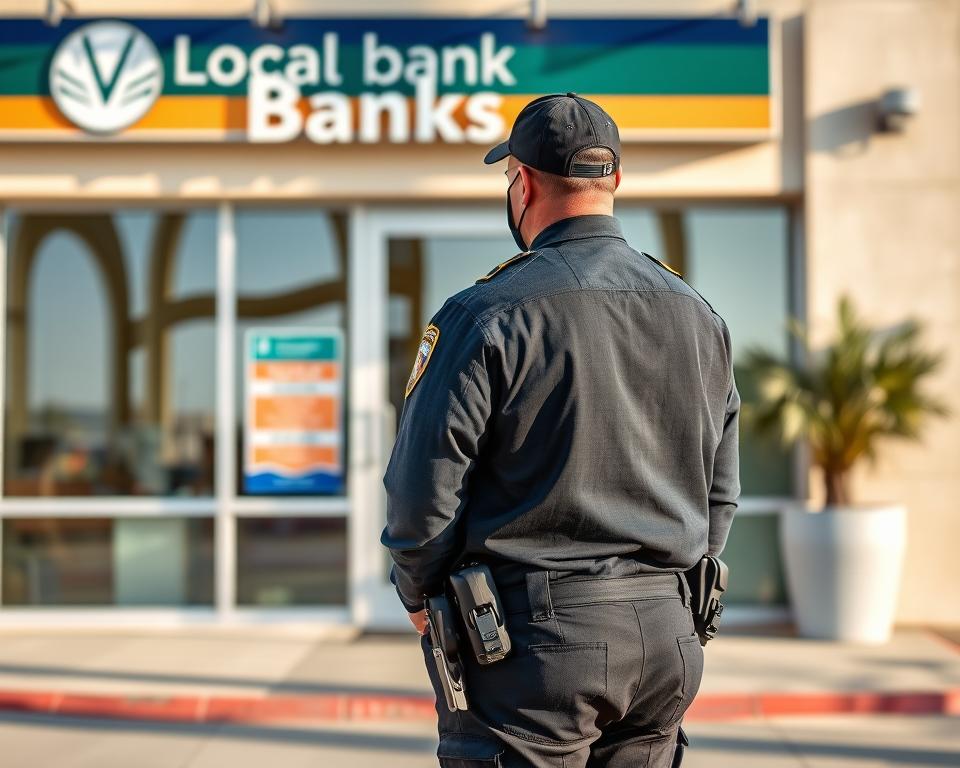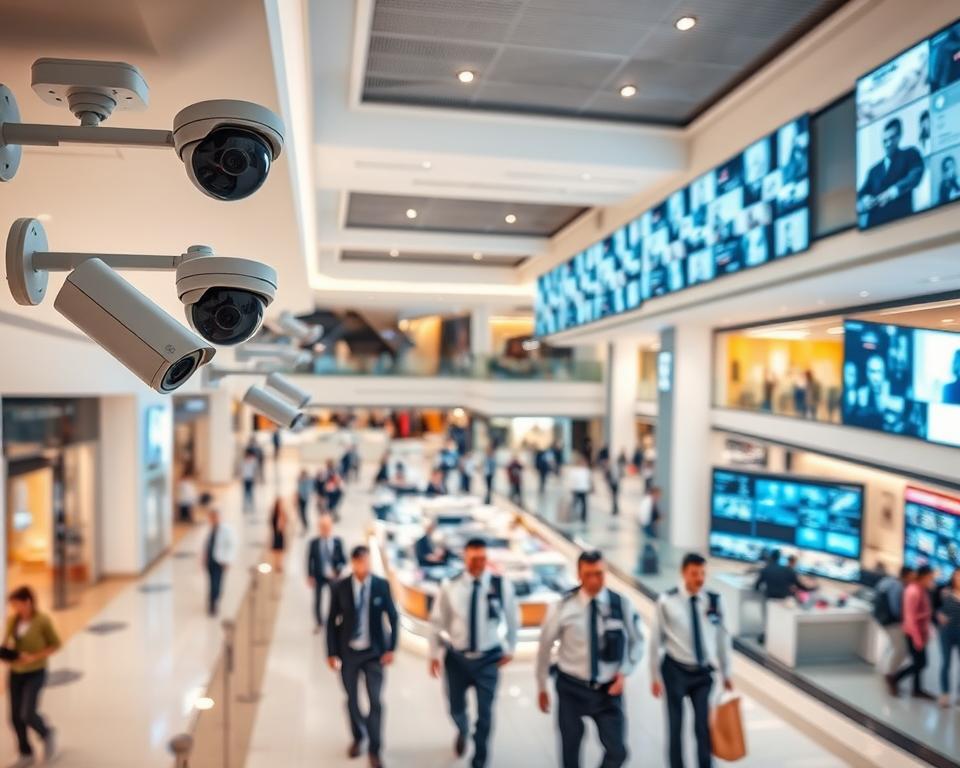Commercial Security in Sacramento: Tailored Approaches for All Business Type
Approximately 60% of companies utilize video surveillance to boost their security. Armed with all-inclusive protection systems, enterprises can reduce losses from theft around 30%. In Sacramento, Divine Guarding Services emerges as a prominent security provider, crafting specialized plans for varying enterprise requirements. They have a decade of know-how and secured the “Corporate Ready” seal from United Airlines and the Golden State Warriors as of 2023.
For businesses ranging from retail to industrial, unarmed security guards Sacramento approaches are crafted to augment safety and boost renter assurance. Every strategy guarantees facilities are properly equipped to counteract emerging dangers. This commitment to security excellence is what distinguishes Divine Protection Services.
Core Takeaways
- Robust safety protocols result in a 30% decrease in losses from theft.
- A significant percentage of companies, around 60%, install video surveillance to enhance protection.
- Divine Guarding Services delivers bespoke strategies satisfy unique security needs in Sacramento.
- With a decade of expertise, Divine Protection is a recognized leader in the industry.
- Having a overt protection display serves to prevent theft and vandalism.
Comprehending the Value of Commercial Property Security
In today’s world, commercial property security is growing in importance. Enterprises face threats like burglary, assault, cybersecurity breaches, and natural disasters. Acknowledging these common threats to commercial properties underlines the necessity for robust protection strategies. These strategies safeguard assets and ensure the safety of staff and customers.
What Makes All-Inclusive Protection Approaches Preferable?
A all-encompassing strategy is at the heart of all-inclusive safeguarding systems. They meld material safeguarding, like observation and access controls, with cybersecurity initiatives. This fusion forms a solid defense system. Studies reveal up to an drop of 80% in unauthorized breaches among enterprises employing cohesive security. Furthermore, 67% of business owners have noted disruptions by protection failures.
Common Threats to Commercial Properties
Comprehending the spectrum of threats that companies encounter today is essential in effective protection planning. Key statistics reveal:
- Enterprise locations are three times more likely to be targeted by burglars than private dwellings, with 30% of small businesses experiencing break-ins.
- There’s been a 300% increase in cybersecurity breaches in the past year, highlighting the critical need for robust digital safeguards.
- Natural disasters and fire hazards pose substantial threats to business premises, making emergency response and fire safety measures vital.
Benefits of Investing in Security Systems
Expenditures on safeguarding systems yield significant advantages that go further than mere burglary deterrence. These gains comprise:
- Boosting workforce and patron security lifts performance, with 75% of enterprises observing improved staff performance post-security upgrades.
- Effective security measures can curtail losses from crime and defacement by around 30%, resulting in significant cost savings.
- Implementing an all-inclusive protection plan establishes a safety culture, with staff vigilance halving crime and fraud occurrences.
The significance of prioritizing security in current corporate environments cannot be overstated. Proactive security measures significantly diminish dangers and improve operational integrity. As security threats evolve, adopting comprehensive security solutions is crucial for every business owner’s agenda.

Categories of Safeguarding Solutions for Companies
The realm of enterprise safeguarding has evolved to tackle the multifaceted issues faced by businesses today. A combination of advanced technologies is required for optimal safeguarding. Available alternatives such as video surveillance systems, access restriction technologies, and alert mechanisms, are crafted to address particular protection requirements. They enhance the overall safety for business premises.
CCTV Systems
Video surveillance systems offer ceaseless supervision, crucial to safeguarding enterprise assets. Commonly called CCTV, these networks permit real-time observation from remote sites. They are extremely useful for providing evidence if events transpire. Moreover, incorporating artificial intelligence, such as visual recognition and behavioral assessment, significantly enhances threat detection.
Access Control Solutions
Access control solutions are crucial for controlling access into confined enterprise zones. They effectively verify identities addressing the who, when, and where questions. In contrast to conventional locking methods, modern entry solutions deliver greater adaptability and diminished maintenance expenses. Combining mobile credentials with biometric access simplifies entry management and enhances protection.
Intrusion Detection and Monitoring
Alert mechanisms and observation systems are vital for complete protection plans. They shield from unwarranted breaches and critical events by signaling safeguard personnel about potential break-ins. Integrating features like intrusion and fire detection, along with environmental monitoring enhances incident response times. Effective setup dramatically lowers the chances of illicit entry.
Tailoring Security Solutions for Your Business Type
Unique security challenges vary by enterprise category, requiring bespoke strategies. Understanding the specific demands of each sector is critical.
Security Requirements for Retail Environments
Shops and storefronts are challenged by security risks from high customer traffic and theft risks. Challenges like shoplifting and employee theft are prevalent. Store operators may require EAS, advanced video monitoring, and enhanced alert systems. More than 50% of shops experience theft losses, emphasizing the necessity for targeted protection plans.
Protection Priorities for Offices
In corporate environments, protecting sensitive data and controlling access are priorities. Security solutions might use access control systems for managing entry. Remote management via mobile devices can boost security. Commitment to protection results in more satisfied occupants and improved productivity, vital for a secure office.
Security Attributes in Industrial Settings
Manufacturing and industrial zones require robust, extensive safeguarding measures due to their specific hazards. Surveillance, perimeter defense, and alarms are vital. Integrating material security with IT protection is progressively vital. A variety of industrial firms implement virtual security measures to ensure unceasing observation and rapid incident management, redefining industry norms.
| Company Classification | Security Needs | Typical Safeguards |
|---|---|---|
| Retail | High customer traffic, theft deterrence | EAS, video surveillance, alarm systems |
| Office Space | Confidentiality measures, access restrictions | Access control systems, monitoring |
| Factory | Edge defense, operational safeguarding | Monitoring, alert mechanisms, digital guarding |
Essential Aspects of a Successful Safeguarding Plan
To create an impactful safeguarding framework demands an intricate methodology. It encompasses critical elements like comprehensive risk evaluations and integrating advanced technologies with proficient staff. Also, it includes perpetual observation and review. Understanding these aspects is vital for constructing a robust protection model. This framework must be adaptable to the particular needs of any commercial setting.
Risk Evaluation and Scrutiny
Risk evaluation is essential for a solid security plan. It helps in pinpointing vulnerabilities, permitting enterprises to target imminent risks. Companies that routinely review their protection measures are 70% better prepared to mitigate emerging risks. A thorough risk assessment can reveal about 30% of flaws in existing security setups, demonstrating its value.
Integration of Technology and Personnel
The fusion of digital tools and human resources is key to strengthening security. Video monitoring can slash crime by half, highlighting the significant impact of modern tools. When combined with proficient personnel, emergency responses become swifter; approximately 80% of breaches are more effectively handled with expert presence. Appropriate instruction may lower incident rates by 40%, validating the role of trained employees.
Perpetual Oversight and Assessment
Ongoing surveillance is vital for addressing changing risks. Periodic reviews help enterprises fine-tune their safeguarding methods, maintaining persistent performance. IT intrusions have increased 300% in the last five years, thereby emphasizing the need for robust cyber and physical safeguards. With thorough observation and regular checks, firms can promptly address risks. This not only strengthens protections but also boosts customer confidence and loyalty.
Local Compliance Standards for Protection
For any company proprietor, understanding regional protection statutes is crucial. Ignoring these standards can lead to major liabilities, like lawsuits and liability problems. States differ in their requirements, especially concerning video surveillance. Understanding these statutes both improves safety and secures the company’s rights.
Understanding Your Legal Obligations
In the U.S., there are no federal mandates for commercial video monitoring. Companies face different rules in each state. While the majority of states permit monitoring, it must not encroach on private spaces such as restrooms. In the state of Connecticut, for example, companies are obligated to notify employees about covert surveillance. This demonstrates the need for transparency in monitoring.
Compliance with Safety Standards
Following safety standards is crucial in commercial environments. By complying with local laws, businesses ensure they protect both employees and customers. Retention of video records should be limited to what is legally required. Observing these guidelines reflects a firm’s commitment to protection and reduces legal risks.
Risk Management and Coverage
Insufficient protection can result in major legal liabilities for business leaders. Failing to notify employees regarding monitoring may cause conflicts, especially during delicate union matters. Legal actions may be initiated by both staff and patrons following a breach. Adequate insurance helps manage these risks. Upholding legal compliance bolsters your position against claims.
Workforce Preparation and Security Consciousness
Establishing a robust protection ethos in a enterprise commences with proper education. Employees are crucial in keeping business spaces safe. They can detect potential risks and act appropriately when properly trained. Budget-friendly training options mean security measures are within reach for all businesses.
Significance of Educating Employees on Protection
Teaching staff about security is vital for reducing risks. Knowing how to handle safety issues and identify threats empowers them. A skilled staff reduces exposure to security risks. This secures business assets and private information. Keeping training up-to-date ensures employees stay alert.
Cultivating a Safety Mindset
A robust protection culture requires commitment from management and active participation by employees. It prosper when risks are openly discussed and crisis actions are understood. When team members take ownership of their surroundings, collaboration in security efforts grows. This environment enhances alertness and rapid response capabilities.
Contingency Action Plans
Businesses need clear plans for emergencies. Educating personnel on crisis procedures speeds up reactions and curbs confusion. Routine simulations and reviews maintain alertness. Integrating economical security devices like well-marked egress points and emergency directories enhances response readiness.
Technology Advancements in Commercial Security
The domain of business safeguarding is changing, owing to modern advancements. State-of-the-art technologies merged with intelligent solutions are reshaping asset protection methods for companies. This combination is fostering a nimble protection plan. It also enhances effectiveness in managing risks.
Smart Tech’s Contribution
In the domain of business safeguarding, smart technology is a game-changer. By 2022, over 1.5 billion IoT devices were installed in intelligent business infrastructures. This integration has improved monitoring and data analysis. Innovations including digital credentials, biometric systems, and immediate alerting enable prompt action.
Innovations in Surveillance and Monitoring
Monitoring technologies have advanced with artificial intelligence video analysis. This technology cuts down false alarms by pinpointing real threats. It analyzes information to pinpoint irregular behavior and important clips. Linking surveillance with Building Management Systems boosts efficiency and security. Preventative maintenance measures contribute by forecasting malfunctions and preserving security.
Upcoming Directions in Protection Technologies
The evolution of business safeguarding is moving towards cloud-centric systems. In 2022, investments in cloud safeguarding surpassed $20 billion, with expectations to hit $97 billion by 2030. There’s a trend toward environmentally conscious protection, focusing on lowering costs and the carbon footprint. The integration of AI with machine learning for early warning is increasing. Information-based safeguarding approaches keep responses advanced, enhancing system resilience.
Collaborating with Expert Protection Providers
Collaborating with expert protection companies offers businesses a solid framework for their security initiatives. It’s vital to select an appropriate protection partner to guarantee that your unique requirements are addressed with customized approaches. The protection field is extensive, so partnering with a provider who can craft a customized security plan is vital. This approach ought to match your operational aims and hurdles.
Choosing the Right Security Provider
When choosing a protection partner, consider their experience, reputation, and the comprehensiveness of their solutions. Renowned firms such as Allied Universal deliver an extensive array of offerings, from workforce supervision to state-of-the-art systems. Evaluating their strategy for continuous service and repairs is critical to their overall protection capability.
Benefits of a Customized Security Partnership
A bespoke protection collaboration meets the specific obstacles encountered by each business. Effective solutions often blend personnel, advanced technology, and expert advice. Utilizing features such as HD surveillance cameras, access control systems, and intelligent alarm systems enhances security. Personal security teams, extensively trained and reviewed, significantly deter crime. This fosters security for both workers and patrons.
Regular Assistance and Preservation
Protection is not a single event; it requires regular service and updates. Routine audits permit refinements in line with emerging risks. Systems like the AI-enhanced HELIAUS® tool facilitate persistent advancements in safeguarding practices. Investing in customer service training and offering access to over 1,500 free training courses keeps personnel sharp in facing security challenges. This perseverance improves patron retention.
| Aspect | Traditional Security Services | Bespoke Safeguarding Systems |
|---|---|---|
| Staff Education | Fundamental instruction offered | Regular training aligned with performance assessments |
| Tech Incorporation | Conventional tools | Cutting-edge solutions designed for specific demands |
| Assistance | Responsive service | Preemptive support with regular reviews |
| Burglary and Vandalism Prevention | Moderate effectiveness | Enhanced prevention thanks to tailored measures |
Assessing the Performance of Your Protection Systems
To protect your commercial property, reviewing the success of your safeguarding protocols is vital. This approach permits enterprises to locate deficiencies and enhance protection, thus averting events that might lead to substantial monetary damage. It’s crucial to grasp the pertinent key performance indicators to accurately measure your protection system’s effectiveness. This knowledge enables refinement of your protection approach based on measurable metrics.
Key Performance Indicators for Security
Essential performance measures (KPIs) are instrumental in evaluating the performance of your safeguarding measures. They include indicators such as reaction times, error rates, and variations in crime statistics following security improvements. Using alert mechanisms, for example, markedly diminishes burglary probability, increasing property safety by 4.57 times. By observing these measures, enterprises can confirm that their safeguarding strategies meet their aims of lowering risks and expenses.
Regular Audits and Updates
Periodic reviews are essential for maintaining compliance with evolving standards and spotting vulnerabilities. These audits ought to inspect all safeguarding tools, like CCTV and alarms, to ensure they operate effectively. Revised protection protocols reduce the likelihood of burglary and defacement and may result in lower insurance premiums. Properties with effective security measures often benefit from decreased insurance premiums.
User Reviews and Progressive Upgrades
Customer feedback is essential for the continuous improvement of protection practices. Dialogues with staff and clients can reveal how security measures affect their daily interactions. This input is key for evolving security policies, ensuring they stay impactful and adapt to new challenges. Focusing on such insights enables businesses to create safer spaces, critically lowering the probability of high-cost incidents, which typically run to $1.02 million per crime.
Frequently Asked Questions
Q: What is commercial property security?
A: Commercial property security involves systems and practices protecting businesses from theft, vandalism, and workplace violence. These protocols are designed specifically to suit the diverse demands of commercial environments.
Q: Why is it important to adopt robust security systems for my company in Sacramento?
A: Allocating resources to robust safeguarding systems is vital. It works to prevent unlawful acts, secure important data, and boost workforce and patron safety. A preventative strategy can reduce the varied risks encountered by companies.
Q: Which protection technologies can companies choose from?
A: Enterprises may select from an array of safeguarding solutions. Options include video surveillance for monitoring, access control solutions for entry management, and alarm systems for emergency alerts.
Q: How can I tailor security solutions to meet the specific needs of my business sector?
A: Customizing protection measures necessitates evaluating your company’s specific risks. Be it installing deterrents for retail theft or emphasizing confidentiality in office spaces, protection protocols must match business needs.
Q: What are the key components of an effective security plan?
A: An effective plan includes risk assessments, technology with skilled personnel, and constant security evaluations. Consistent evaluations allow for adaptations to new risks, maintaining secure operations.
Q: Which statutory duties pertain to enterprise safeguarding?
A: Company leaders need to follow local compliance guidelines. Sufficient security steps help defend against legal challenges and reduce accountability concerns.
Q: How important is employee training in a security strategy?
A: Educating staff on protection protocols is essential for cultivating a safety-focused environment. Educating team members on security practices improves alertness and mitigates potential threats.
Q: Which innovative tech developments are influencing business safeguarding?
A: Advancements include smart technology for improved surveillance and access control, AI systems for anomaly detection, and virtual guarding trends.
Q: How does teaming up with a specialized safeguarding provider like Divine Protection Services help my business?
A: Partnering with professionals ensures access to customized solutions and ongoing support. It allows businesses to adapt their security measures over time effectively.
Q: How can I evaluate the effectiveness of my security measures?
A: Measurement can be achieved through monitoring key metrics, performing regular reviews, and gathering client input. This helps identify gaps and continuously improve security systems.

